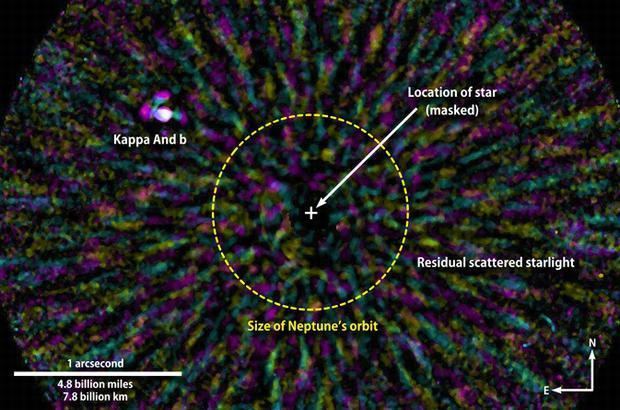Magnitude 4.139 Apparent magnitude (V) 4.139 | ||
 | ||
Similar Kappa Andromedae b, Upsilon Andromedae, Epsilon Andromedae, Omicron Andromedae, Zeta Andromedae | ||
Kappa andromedae b massive star s super jupiter
Kappa Andromedae (κ And, κ Andromedae) is the Bayer designation for a bright star in the constellation of Andromeda. Its apparent visual magnitude is 4.1. Based on the star's ranking on the Bortle Dark-Sky Scale, it is luminous enough to be visible from the suburbs and from urban outskirts, but not from brightly lit inner city regions. Parallax measurements made during the Hipparcos mission place it at a distance of approximately 168 light-years (52 parsecs) from Earth.
Contents
- Kappa andromedae b massive star s super jupiter
- Planeta gigante kappa andromedae b
- Naming
- System
- References
Kappa Andromedae has a stellar classification of B9 IVn, indicating that it is a subgiant star in the process of evolving away from the main sequence. It has 2.3 times the radius of the Sun and is spinning rapidly, with a projected rotational velocity of 176 km/s. The outer envelope of the star is radiating energy into space with an effective temperature of 11,361 K, producing a blue-white hue.
Planeta gigante kappa andromedae b
Naming
In Chinese, 螣蛇 (Téng Shé), meaning Flying Serpent, refers to an asterism consisting of κ Andromedae, α Lacertae, 4 Lacertae, π2 Cygni, π1 Cygni, HD 206267, ε Cephei, β Lacertae, σ Cassiopeiae, ρ Cassiopeiae, τ Cassiopeiae, AR Cassiopeiae, 9 Lacertae, 3 Andromedae, 7 Andromedae, 8 Andromedae, λ Andromedae, ι Andromedae, and ψ Andromedae. Consequently, κ Andromedae itself is known as 螣蛇二十一 (Téng Shé èrshíyī, English: the Twenty First Star of Flying Serpent).
System
In November 2012, a young, hot gas giant planet about 13 times the mass of and slightly larger than Jupiter was directly imaged in orbit around κ And at a projected separation of 55 ± 2 AU.
Observations at multiple wavelengths indicate a temperature of about 1700 K and the estimated age is approx. 30 million years.
In September 2013, the mass of the companion was revised to be 50±13 Jupiter masses due to a much older estimated age for the star, 220±100 million years. This makes it a brown dwarf and it is given a spectral type of L1. The companion is shining by its residual heat of formation, cooling as it ages. As a result, an older system age implies a larger mass (and initial supply of energy) to reach the same current brightness. This more recent study used data from the Project 1640 integral-field spectrograph to fit a temperature of about 2,040 K.
A 2016 study calculated the age of Kappa Andromedae from its rotational velocity, luminosity and oblateness, and came up with an age of the system of 47+27
−40 million years and a mass of 22+8
−9 Jupiters for the companion.
